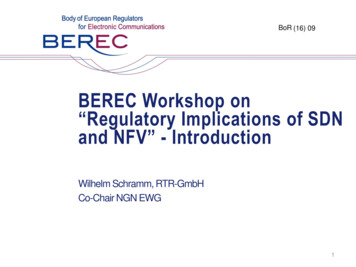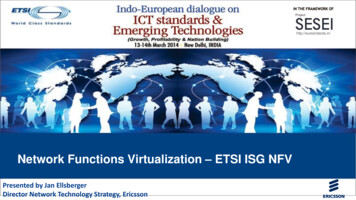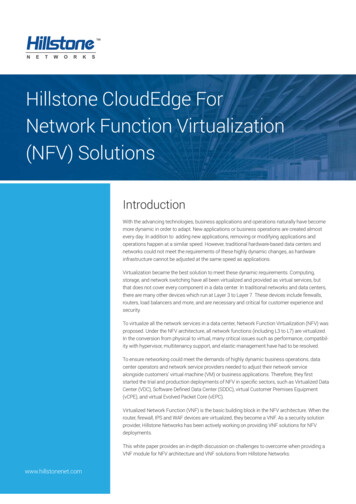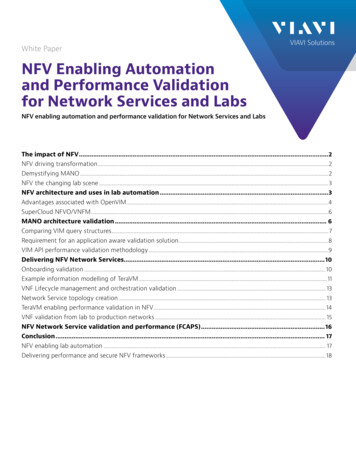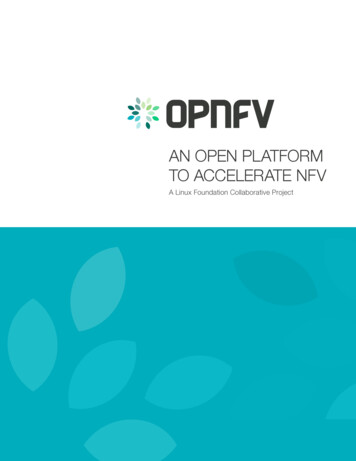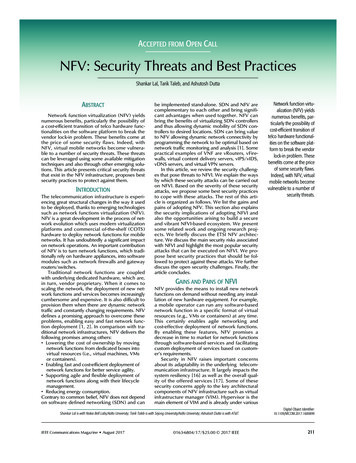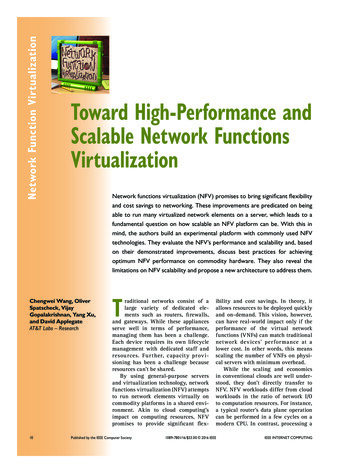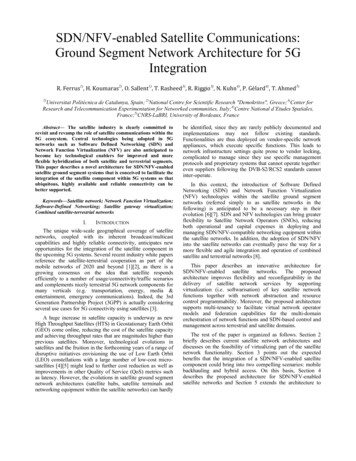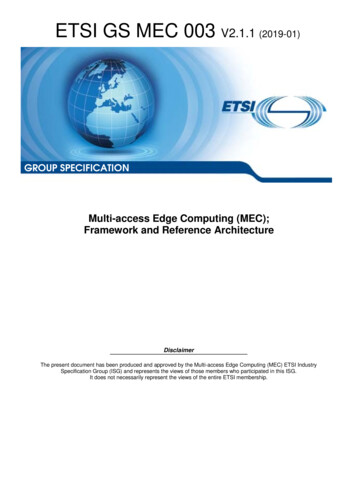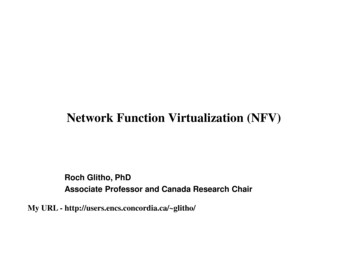
Transcription
Network Function Virtualization (NFV)Roch Glitho, PhDAssociate Professor and Canada Research ChairMy URL - http://users.encs.concordia.ca/ glitho/
References1. R. Mijumbi et al., Network Function Virtualization: State of the Art and ResearchChallenges, IEEE Communications Surveys and Tutorials, First Quarter 20162. J.G. Herrera and J.F. Botero, Resource Allocation in NFV: A ComprehensiveSurvey, IEEE Transactions on Network and Service Management, September20163. ETSI Specifications on NFV Use Cases, GS NFV 001, 2013-10
Network Function Virtualization Motivation Principles and Use Cases Architecture and Business model NFV, Cloud and SDN
Network Function Virtualization- Work initiated in 2102 and mostly done by an industry consortium: The EuropeanTelecommunications Standards (ETSI)
Motivation
MotivationAddress the problem paused by the proliferation ofmiddleboxes in current networks (i.e. cost)
MiddleboxesDefinition:- Specialized hardware that performs a network service- Network service“Anything” which is not packet forwarding
MiddleboxesExamples:- Network Address Translation (NAT)-FirewallDeep Packet Inspection (DPI)EncryptionDecryptionIP address assignment (e.g. DHCPCustomer Premise Equipment (CPE)
Customer Premise EquipmentThe specific case of customer premise equipment (CPE)- Equipment installed at customer premises but belonging toa service provider- Might be residential or corporate- TV set up boxes- Firewalls- NAT- A typical CPE has typically several functions in a singlehardware boxes.
Customer Premise Equipment (Ref. 1)
Cost Issues Related to Middleboxes(As illustrated by the CPE)Examples- High purchasing cost- High maintenance cost- Highly specialized maintenance staff- Need to physically go to customer premises (or discuss withcustomers) to add / remove / upgrade function- Short life cycle
NFV Vision(As illustrated by the CPE – Ref 1)
NFV Solutions to Cost Issues(As illustrated by the CPE)NFV Solution: Network Function Decoupled FromHarware and implemented as Virtual Network Function(VNF) running on commodity hardware:
NFV Solutions to Cost Issues(As illustrated by the CPE)Advantages:- Lower purchasing cost, software costing less thanspecialized hardware- Lower maintenance cost- Could run and be operated anywhere including serviceprovider premises- Short life cycle
Principles and Use Cases
Principles- Decoupling of physical network equipment from thefunctions they run- Functions are known as Network Functions- Examples of Network Functions- Routing- Firewall- DHCP- NAT- UPnP
Principles- Leveraging of virtualization to implement the networkfunctions- Virtual Network Functions- Examples- vRouting- vFirewall- vDHCP- vNAT- vUPnP
Principles- Implementation of specific network service bychaining VNFs- VNF chains are also known as service chains
PrinciplesExample of service chain (Reference 2)
PrinciplesFrom proprietary hardware to VNF in data centres(Reference 2)
PrinciplesFrom proprietary hardware to VNF in data centres- What are the advantages? (Class discussion)
Use Case 1: CPE again (Ref. 3)Enterprise setting
Use Case 1: CPE again (Ref. 3)Enterprise setting
Use Case 2: CPE again (Ref. 3)Home settingEssentially:- Residential gateways (i.e. NAT, DHCP)- Set up boxes
Use Case 2: CPE again (Ref. 3)Home setting
Use Case 2: CPE again (Ref. 3)Home setting
Use Case 2: CPE again (Ref. 3)Home setting
Use Case 2: CPE again (Ref. 3)Home setting
Use Case 3: Content Delivery Networks
Use Case 3: Content Delivery Networks
Use Case 3: Content Delivery NetworksWhat about deploying surrogate servers at ISPpremises to be closer to end-users?- How is it currently done?- Dedicated hardware / server physically “manually”deployed at ISP premises (e.g. Netflix Openconnect;Akamai Aurora)- Long process- Lack of flexibility (e.g. provisioned for peak hours / use)
Use Case 3: Content Delivery NetworksProvisioning with VNFs (Ref. 3)
Architecture and Business Model
Architecture (Ref. 1)
Architecture1. NFV Infrastructure (NFVI)- Hardware and software environment for deployment andexecution of VNFs.- Commodity hardware- Hypervisor- Openstack is currently often used but does not yet meet allperformance requirements
Architecture2. Virtual Network Function and Services- VNF- Implementation of an NF deployed on virtual resources(e.g. VM)- VNS- Implementation of network services as a set of one ormore VNF
Architecture2. NFV Management and Orchestration (MANO)- VNF provisioning (e.g. configuration)- VNF life cycle management- VNF coordination (e.g. orchestration)- Software Defined Networks (SDNs) might be used forthe orchestration
Business Model
Business Model (Ref. 1)1. Infrastructure providers:- Deploy and manage physical resources on which thevirtual resources may be provisioned and leased totelecommunication service providers-Could be public data centres provided they meet theperformance requirementsCould be the telco service provider itself- Resources could be provisioned over several domains bycoalition of providers.
Business Model (Ref. 1)2. Telecommunication service providers:- Lease resources from one or several infrastructureproviders- Determine how VNFs should be chained to realizespecific network services for end-users
Business Model (Ref. 1)2. and 3. VNF providers and server providers:- VNF providers offer software implementation of NF-Could be done by third parties or telecommunication serviceproviders- Server provider offer commodity servers to infrastructureproviders which may be the telecommunication serviceproviders
Business Model (Ref. 1)5. Brokers- Used for publication and discovery-VNFsInfrastructuresServers May not exist
Business Model (Ref. 1)6. Users- Final consumers
NFV, Cloud and SDN
NFV, Cloud and SDN (Ref. 1)
NFV, Cloud and SDN (Ref. 1)
NFV, Cloud and SDN (Ref. 1)
NFV, Cloud and SDN (Ref. 1)
NFV, Cloud and SDN (Ref. 1)
AThe End.
1. R. Mijumbi et al., Network Function Virtualization: State of the Art and Research Challenges, IEEE Communications Surveys and Tutorials, First Quarter 2016 2. J.G. Herrera and J.F. Botero, Resource Allocation in NFV: A Comprehensive Survey, IEEE Transactions on Network and Service Management, September 2016 3. ETSI Specifications on NFV Use .
